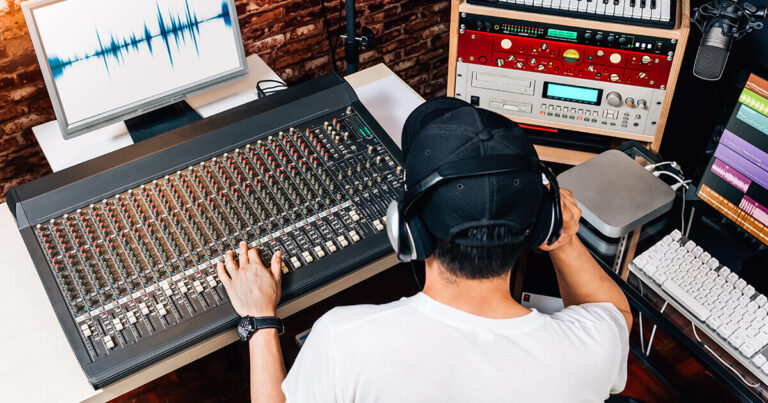Mixing and mastering are two of the most important steps in music production. They play an integral role in creating a professional sounding record by blending individual instruments and sounds together to create a single cohesive mix, while also applying subtle modifications to enhance the overall sound.
The comprehensive guide for mixing and mastering provides readers with a detailed breakdown of these processes, exploring their importance, techniques used by professionals, like Raz Klinghoffer, and best practices when it comes to achieving great results on any project.
1. Introduction to Mixing and Mastering

Mixing and mastering are two essential processes in music production. They give a track its shape, texture, and dynamics, allowing it to stand out from the competition. Mixing involves combining individual recordings into a single cohesive piece of audio while mastering is the process of fine-tuning this mix so that it sounds as good as possible when played back on different systems.
This comprehensive guide will provide an introduction to mixing and mastering for those just starting their journey in audio engineering. It will explain what each process entails, how they work together to create a great-sounding track and provide tips on achieving the best results from both stages of production.
2. Understanding the Mixing Process
The mixing process is a critical element of the music production cycle and involves balancing all the different elements that make up a song. This includes not just instruments, but also vocals, effects, and more. During this stage of production, producers must consider the overall sonic landscape of their track – from volume levels to panning (left/right placement) – so that each individual instrument is featured in a way that works for the whole composition.
Additionally, producers can apply techniques such as equalization (EQ), compression and reverb to further enhance or modify each track’s sound. The result should be an aesthetically pleasing mix with clear audio separation between instruments at every part of the song. Understanding how to properly mix your own tracks will help you produce professional-sounding recordings and give you greater control over your final product!
3. Dealing with Technical Challenges in Music Production

Mixing and mastering are two critical processes in music production that can make or break a track. Mixing is the process of taking multiple recorded tracks and blending them together to create a single cohesive sound. Mastering, on the other hand, is the final step in post-production where an experienced engineer applies further processing such as equalization, compression, stereo enhancement and limiting to bring out the best from each track and to achieve uniformity across all tracks present.
Both of these processes require technical knowledge, skill and experience to ensure that your mix stands out from others. Technical challenges during mixing may include dealing with poorly balanced audio signals; dealing with different dynamic ranges between instruments; selecting appropriate EQs for various sounds; using effects appropriately including reverb, delays etc., while mastering involves understanding how loudness affects perception of sound; balancing levels relative to one another so they blend well without clipping when played through consumer systems such as radio or television broadcast speakers, etc.; ensuring compliance with broadcast standards such as peak/loudness ratio (LUFS); preparing files for streaming services like Spotify or iTunes by compressing them so they don’t exceed maximum size limits among other things.
4. Working with a Professional Audio Engineer
Mixing and mastering are two essential processes in music production. They are the last steps before releasing a song or album and involve working with a professional audio engineer to ensure that your project sounds as good as it possibly can. Mixing is the process of blending together all of the individual tracks within a song, while mastering is the final step in polishing and balancing each track so that they sound great when played on different playback systems.
Working with an experienced audio engineer will help you to achieve optimal results for your project by using their expertise to create unique sonic textures, craft dynamic mixes, balance levels between instruments, enhance clarity and stereo imaging, apply EQ and compression treatments, add effects processing etc., all leading up to achieving the perfect master mix. Having a professional audio engineer involved in this process ensures that what you hear is exactly what you intended it to be – allowing your music to really shine through!
5. Best Practices for Recording and Editing Tracks

Mixing and mastering are two of the most important steps in music production. Without proper mixing, the sound quality of a track can be compromised, while mastering ensures that all tracks have a uniformed level of volume and clarity to create an album-ready version. Mixing involves combining multiple audio sources together to form one cohesive song or instrumental piece, while mastering is the process of further enhancing this mix down by manipulating frequencies and dynamics.
This comprehensive guide will provide best practices for recording and editing tracks with an emphasis on how to properly use mixing and mastering techniques within a professional context. In addition, it will cover various tips for creating balanced mixes, optimizing your workflow during the mixing process, as well as useful plugins for achieving certain sounds or effects during post-production. With these tools at your disposal, you’ll be able to craft professional sounding mixes that are ready for distribution!
6. Essential Tools for Music Production and Mixing/Mastering
Mixing and mastering are two essential processes in the music production process. They give a track its professional, polished sound. In essence, they provide the sonic glue that brings together all of the elements in your song or project. Mixing is an art form which requires a great deal of skill and experience to get right, while mastering is more technical and involves making sure everything sounds balanced when played back on various systems. Fortunately, there are plenty of tools now available to help with both mixing and mastering so that anyone can produce amazing audio projects.
Today’s modern music producers have access to high-end plugins such as compressors, EQs, limiters and other specialized effects processors which allow them to create complex mixes quickly and easily from their home studio setup. Additionally, there are many online services such as mastering engineers who specialize in creating high-quality masters for digital distribution platforms like iTunes or Spotify.
7. Finalizing Your Project: Preparing Your Song For Commercial Release

Mixing and mastering are two of the most important steps in music production. Mixing involves combining different tracks into a single, cohesive piece of music. Mastering is the process of polishing those individual elements to create a final product that is ready for release. Together, mixing and mastering play an essential role in ensuring that your song has the highest quality possible when it comes time for commercial release.
Mixing helps to enhance the sound by balancing each track’s volume levels, adding effects such as compression or EQ (Equalization), and creating an overall mix that sounds great on all playback systems. This step allows you to bring out nuances in your recording while maintaining clarity throughout its duration. Additionally, mixing can also help set up dynamics like crescendos and decrescendos so they fit better with other aspects of your composition.
Mastering focuses more on enhancing the overall sound quality rather than manipulating individual elements within a track; it includes things like limiting frequencies for greater clarity, applying equalization to ensure a balance between instruments or vocals across all speakers/playback devices, setting proper levels for stereo imaging and panning tracks appropriately, etc.
Conclusion
The conclusion of The Role of Mixing and Mastering in Music Production: A Comprehensive Guide 2024 essay serves to summarize the key points that have been discussed throughout. It is important to note that mixing and mastering are essential aspects of music production, as they work together to create a polished, professional sound.
Furthermore, it is necessary for producers to understand the fundamentals of both processes in order to effectively use them. Finally, while there are numerous tools available today for advanced mixing and mastering techniques, having a good understanding of the basics will still prove invaluable in producing great results.

